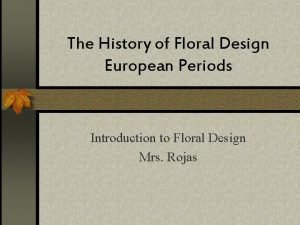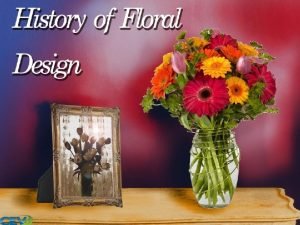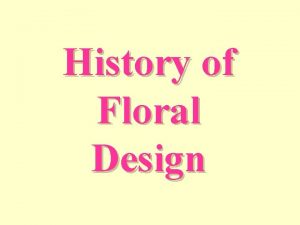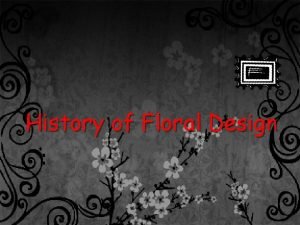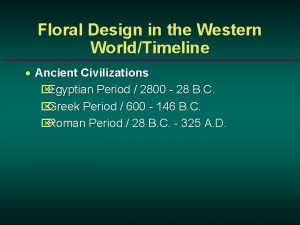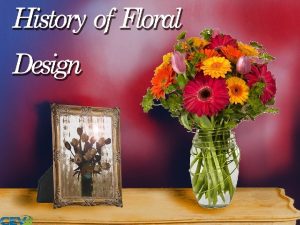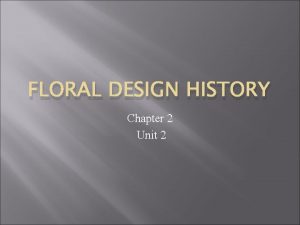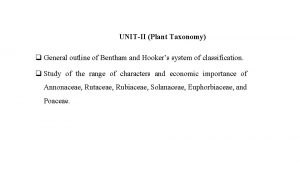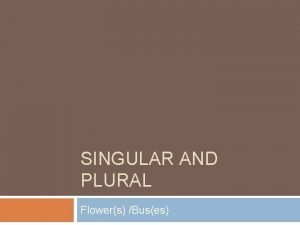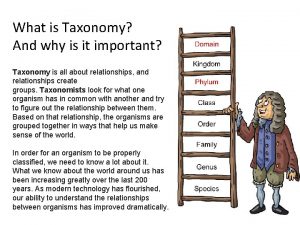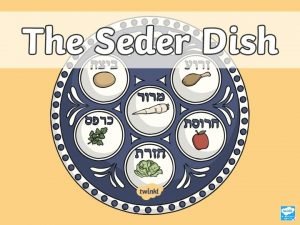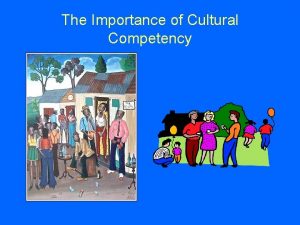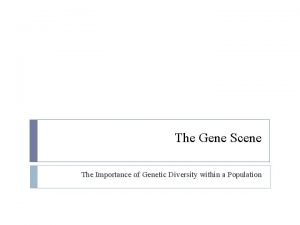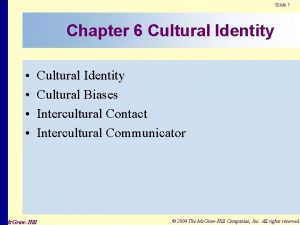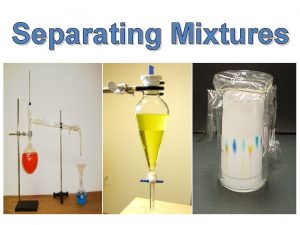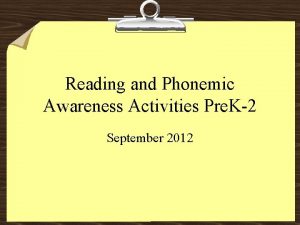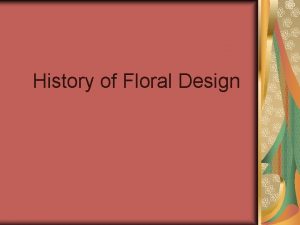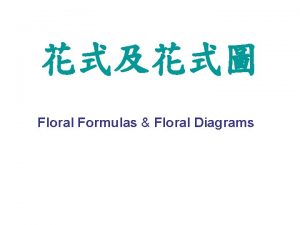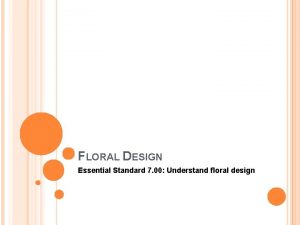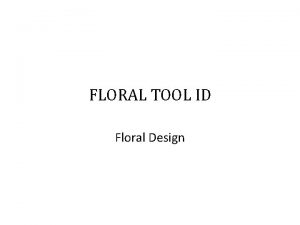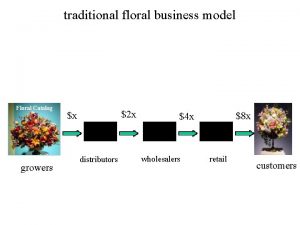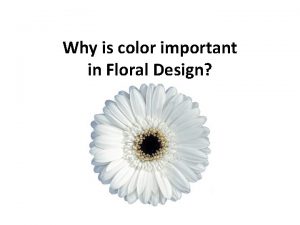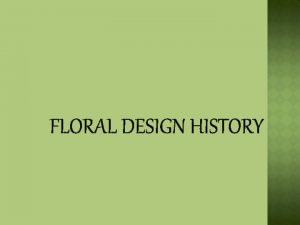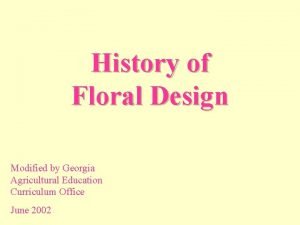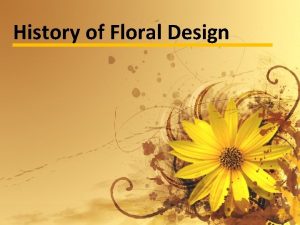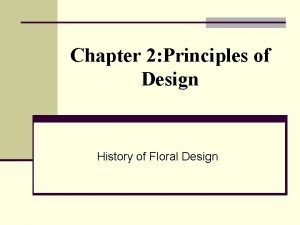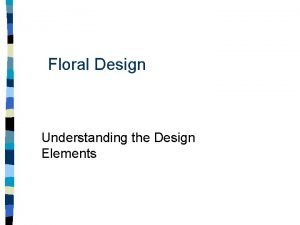History of Floral Design Why is it important








































































- Slides: 72

History of Floral Design

Why is it important? • To create arrangements with the feel of another time and place. • To harmonize your arrangements with the time period of the room or building. • Floral artists of today inherit the floral art of the ages. • The art of floral design has a rich worldwide history • The art of arranging flowers goes back to ancient cultures • We can learn a great deal from the past. • It is exciting to learn the ways flowers were used or arranged by different groups of people during different time periods.

The Different Historical Periods • • • Ancient Civilizations European Oriental American Modern

ANCIENT CIVALIZATIONS

Floral Design in Ancient Civilizations 2800 B. C. – 600 A. D. • Egyptian • Greek • Roman • Byzantine

EGYPTIAN PERIOD 2800 B. C. – 28 B. C.

Egyptian Period: Containers • Egyptians favored wide-mouthed containers • Containers were often made from pottery, gold, slate, or polished alabaster • Farrence -- Type of glazed earthenware from Italy that was often used in containers

Egyptian Period: Design Characteristics • Common types of designs were chaplets, wreaths, garlands • Designs were typically orderly with alternating patterns of flowers • Dominant colors were red, yellow, and blue

Egyptian Period: Flowers • Acacia • Morning Glory • Gladiolas • Poppy • Jasmine • Rose • Lily • Lotus** • Lupine ** The lotus flower (water lily) was the flower of the Egyptian Goddess, Isis, and was considered sacred

Egyptian Period: Foliage & Fruit • Ivy • Olives • Laurel • Palm • Oleander • Papyrus • Figs • Peaches • Grapes • Plums

GREEK PERIOD 600 B. C. – 146 B. C.

Greek Period: Containers • Flower petals were often scattered on the ground during ceremonies • Design types often used were wreaths and garlands • The cornucopia was first introduced during this era

Greek Period: Containers • Very few vases were made solely for the purpose of holding flowers. Instead, flower petals were often scattered on the ground during ceremonies • Design types often used were wreaths and garlands • The cornucopia was first introduced during this era, known as the horn of plenty.

Greek Period: Flowers • Crocus: (saffron spice)** ** Greek red saffron or "Crocus", a pure product of the Greek land, is considered to be the best in the world. A precious spice, adds an exquisite flavor and color to food and drinks. It is also used in distilleries, dairy products and in numerous other applications. • Daisy: • Honeysuckle:

Greek Period: Foliage • Herbs • Ivy Herbs: Greece produces some of the most exquisite spices, herbs and aromatic plants in the world. The most renowned of them are: • • • Oregano Mountain Tea Sage Rosemary Basil Dill • Oak • Laurel

Greek Period: Fruit • Berries The olive tree is • Olive In the background are thirty two leaves and twenty berries, representative of the 32 permanent teeth and twenty children's teeth. • Acorns • Grapes The first cultivation of the olive tree worldwide took place in Greece, and more specific in Crete. inextricably linked with Greek history, culture and life, as is olive oil, the product of its fruit, which the Greeks refer to simply as "oil".


ROMAN PERIOD 28 B. C. to 325 A. D.

Roman Period • • Often used heavy & elaborate wreaths Used fragrant flowers with bright colors First use of natural bouquets Rose blossoms and petals were scattered lavishly on banquet tables, streets, and lakes during festivals and ceremonies

BYZANTINE PERIOD 320 A. D. – 600 A. D.

Byzantine Period • Used symmetrical tree-like compositions • Cones and Spiral designs • Changed construction of garlands to be narrow bands of flowers or fruit alternated with foliage

EUROPEAN

Floral Designs in European Periods • Middle Ages • Renaissance • Baroque • French • English-Georgian • Victorian

MIDDLE AGES 476 A. D. - 1450 A. D.

Middle Ages • Very little is known about floral art in this period • Fragrant flowers were highly favored for strewing on the ground, freshening the air, and making wreaths/garlands

RENAISSANCE 1400 A. D. – 1600 A. D.

Renaissance Period in Europe after Middle Ages • Paintings from this period often show vases of flowers because flowers had great symbolism – ex: The rose symbolized sacred or profane love – ex: A white lily symbolized chastity and fertility

Renaissance: Design Styles • Single white lily placed in a jug is typical • Flowers arranged in vases so that only blossoms were visible • Massed, symmetrically stiff, compact arrangements common • Bright colors and forms of flowers were used as focus

Renaissance: Containers • Elaborate metal containers with well formed bases, stems, necks, & handles popular • Some containers were made especially for flowers (ex: holes in a removable lid to hold flowers in place) • Urns made of pottery, marble, bronze, or glass

Renaissance: Flowers • • • Anemone Campanula Carnations Iris Poppy Rose • • • Lily of the Valley Marigold Narcissus Pansy Violets

Renaissance: Foliage • • Boxwood Cones Fruit Ivy • • Laurel Myrtle Olive Vegetables

BAROQUE and DUTCH FLEMISH 1600 A. D. - 1775 A. D.

Baroque Period Era following the Renaissance in Europe • Art is no longer just for the church or nobility, it is now accessible to the middle class • Paintings show arrangements in everyday settings • Many interiors were overdecorated and gaudy • Designs became more creative and expressive

Baroque Period: Containers • Massive and sturdy • Metal and stone urns • Chinese and Japanese vases, bowls, and flasks

Baroque Period: Flowers • • • Carnations Cyclamen Foxglove Iris Larkspur Lilies • • • Marigolds Roses Sunflowers Snowball Tulips

Baroque Period: Foliage & Accessories • • Leaves of flowers Coleus Olive Bold leaves • • • Fruits/vegetables Birds’ nests Shells Insects Nuts, berries

FRENCH 1600 A. D. – 1700 A. D.

French Period (17 th & 18 th century France) • Also known as the “Grand Era” • Associated with the courtly life • Emphasis was on classic design, refinement, and elegance • Designs were often fan shaped and massed

French Period: Containers • Elegant and ornate • Goblets and vases made of glass, ceramic, or porcelain • Classic urns

French Period: Flowers & Foliage • • Acacia Aster Carnation Ferns Hyacinth Larkspur Lilacs • • • Lilies Marigolds Pansy Poppy Roses Tulips

ENGLISH - GEORGIAN 1714 A. D. - 1760 A. D.

English-Georgian Period (18 th century England) • Named for English Kings George I, II, & III • Fragrance was very important in flower selection because it was thought to rid disease • English created the nosegay to safeguard from illness • Flowers became part of fashion in hair, around necks, and in décolletage • Arrangements were formal & symmetrical • Often used bough pots

English-Georgian: Containers • • • Wedgwood Posy-holder vases Urns made of pewter, sliver, or ceramics Ceramic wall pockets Enclosed bricks

English-Georgian: Flowers Used the same as the Baroque period but also included: • Clover • Geraniums • Hibiscus • • Passion Flower Phlox Snowdrop Veronica

VICTORIAN 1837 A. D. – 1901 A. D.

Victorian Era • Named for Queen Victoria who reigned in England from 1837 to 1901 • Victorian interiors were lavishly decorated in heavy colors and patterns • Time of great enthusiasm about flowers; floral design was taught and recognized as art • First attempt to establish rules for floral arranging

Victorian Era: Design Characteristics • Described as grouping large masses of flowers, foliage, and grasses together to create a design with no center of interest • Usually round or oval shaped arrangements

Victorian Era: Containers • Metal, porcelain, ceramic, glass, and alabaster were popular materials • Wall pockets • Tussie-mussie holders • Vases of various shapes • Urns & jugs

Victorian Era: Flowers • • • Bleeding Heart Camellias Carnations Dahlia Gardenia Hydrangea • • • Lilies Poppies Roses Sweet Pea Tulips Violets

Victorian Era: Foliage & Accessories • Ferns • Grasses • Dried Flowers • Figurines • Stuffed birds, butterflies • Victorian greeting cards

ORIENTAL INFLUENCE

Oriental Influence in Floral Design • Oriental influence placed emphasis on the individual form, texture, and color of plant material • Felt it was improper to place flowers carelessly on the altar. • Created symbolic arrangements • Bright colors were favored.

Chinese vs. Japanese Style • Chinese style is less stylized • Japanese style is very formal and follows strict rules of construction • Ikebana

American Styles of Floral Design • Early American • Colonial • Neoclassic • American Victorian

Early American Style • Focused on natural styles and arrangements • Wildflowers, grains, and grasses were often placed in everyday jugs and pitchers to make an arrangement

COLONIAL 1714 A. D. – 1780 A. D.

Colonial Style • Typical arrangements were massed, rounded, and fan shaped bouquets • Casual, open designs were popular

NEOCLASSICISM FEDERAL AND GREEK REVIVAL 1790 A. D. – 1825 A. D.

Neoclassic Style • Covered two time periods – Federal Period 1790 - 1825 – Greek Period 1825 - 1845 • Designs were typically broken from English tradition and were influenced by the French • Roses, geraniums, and trailing ivy were popular plant materials

AMERICAN VICTORIAN 1845 A. D. – 1900 A. D.

American Victorian • Also called the Romantic era • Designs copied European Victorian styles • Epergnes were popular containers

MODERN

Modern Styles of Floral Design • Art Nouveau • Art Deco • Free Form Expression • Geometric Mass Design

ART NOVEAU 1890 A. D. – 1910 A. D.

Art Nouveau Period • Style was based on curvilinear lines and often patterned after nature in the shape of plants or flowers • Containers were curving and asymmetrical

ART DECO 1920’s & 1930’s

Art Deco Period: • Blending of influences including ancient Egyptian, Jazz age, and industrial age • Characterized by strong geometric lines and patterns • The style reemerged in the 1960’s

FREE FORM EXPRESSION 1950 – 1959 A. D.

Free Form Expression • Arrangements were more expressive with feeling of movement and freedom • Textural differences between design materials were emphasized

GEOMETRIC MASS 1960 -1975 A. D.

Geometric Mass Design • Tight, geometric bouquets were common • Arrangements combined mass and line into stiff patterns • Compote containers were commonly used

Review • What are some types of flowers and foliage common to all periods of floral design? • Why is it important to study the history of floral design? • What are some reasons for changing design styles across time? • How did European traditions influence American design?
 Floral pricing worksheet answer key
Floral pricing worksheet answer key Andreas carlsson bye bye bye
Andreas carlsson bye bye bye Middle ages floral design
Middle ages floral design French baroque floral design
French baroque floral design Flowers together
Flowers together Classical revival floral design
Classical revival floral design Egyptian floral arrangements
Egyptian floral arrangements Floral design history
Floral design history Egyptian floral design
Egyptian floral design American federal floral design history
American federal floral design history Early american period floral design
Early american period floral design Floral formula annona squamosa floral diagram
Floral formula annona squamosa floral diagram Flower en plural
Flower en plural Dont ask
Dont ask Newspaper article format
Newspaper article format From most important to least important in writing
From most important to least important in writing Least important to most important
Least important to most important Important dates in italian history
Important dates in italian history Ffa official dress female pants
Ffa official dress female pants Parts of the ffa emblem
Parts of the ffa emblem Why is the crucifixion important gcse
Why is the crucifixion important gcse Footwork in netball
Footwork in netball Items that distort or prevent communication
Items that distort or prevent communication Why experience is important
Why experience is important Strategic plan example
Strategic plan example Why is water important to living things
Why is water important to living things Why is reading so important
Why is reading so important Define physical diversity
Define physical diversity Why careful selection is important
Why careful selection is important Why are rivers important
Why are rivers important What is taxonomy and why is it important?
What is taxonomy and why is it important? Why is self-awareness important
Why is self-awareness important Shat is passover
Shat is passover Why is advent important
Why is advent important What is ramadan
What is ramadan Why are wetlands important
Why are wetlands important Zero-base forecasting
Zero-base forecasting Why is uml important
Why is uml important L
L Why is time management important
Why is time management important We need quality food justify
We need quality food justify Why is culture important
Why is culture important Importance of compliments
Importance of compliments 3 health triangle
3 health triangle Why is genetic diversity important
Why is genetic diversity important Why is the sun important
Why is the sun important Why is keyboarding important
Why is keyboarding important Genus order family
Genus order family Why are symbols important
Why are symbols important Summarize reading
Summarize reading Why organic social media is important
Why organic social media is important Why is culture identity important
Why is culture identity important Filtration used to separate
Filtration used to separate Why is the greenhouse effect important
Why is the greenhouse effect important Moment of inertia hoop
Moment of inertia hoop Why break-even point is important
Why break-even point is important Fermentation
Fermentation Refusal skills examples
Refusal skills examples Phoneme identity activities
Phoneme identity activities Important of fasting in islam
Important of fasting in islam Why punctuation is important
Why punctuation is important Why is feedback important
Why is feedback important Why is cellular respiration important
Why is cellular respiration important Julia lane coleridge
Julia lane coleridge Onomatopoeia sound device examples
Onomatopoeia sound device examples Why is performance management important?
Why is performance management important? Parallelism grammar definition
Parallelism grammar definition Why is the sun so important
Why is the sun so important Aspect of community
Aspect of community Modifiers of human acts tagalog
Modifiers of human acts tagalog Interphase of cell cycle
Interphase of cell cycle Why biodiversity is important
Why biodiversity is important Marigold by eugenia collier
Marigold by eugenia collier


